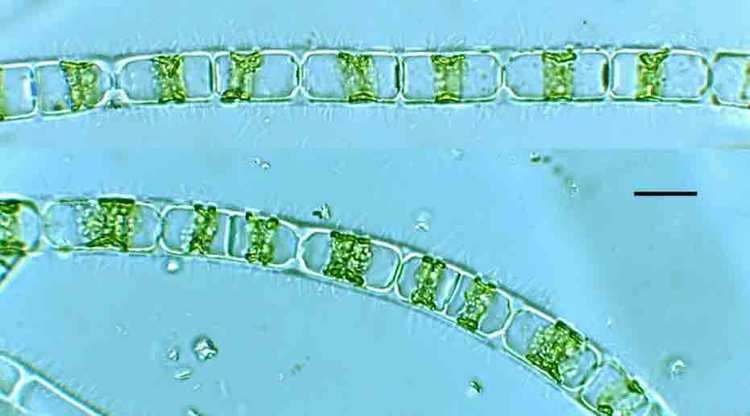Domain Eukaryota | Kingdom Viridiplantae Scientific name Ulothrix | |
 | ||
Similar green algae, Water silk, Oedogonium, Cladophora, Globe algae | ||
In taxonomy, Ulothrix is a genus of green algae, specifically of the Ulotrichaceae.
Contents
Ulothrix is a genus of filamentous green algae, generally found in fresh and marine water. Its cells are normally as broad as they are long, and they thrive in the low temperatures of spring and winter. They become attached to surfaces by a modified holdfast cell. Reproduction is normally vegetative. They are Eukaryotic and unicellular. They are one of the 5 classes of microorganisms.
The genus includes:-
Ulothrix aequalis Kützing; Ulothrix moniliformis Kützing Ulothrix flacca (Dillwyn) Thuret in Le Jolis Ulothrix implexa (Kützing)Kützing Ulothrix speciosa (Carmichael ex Harvey in Hooker) Kützing Ulothrix tenerrima Kützing Ulothrix tenuissima Kützing Ulothrix zonata (Weber et Mohr) Kützing
Structure

The plant body consists of unbranched, uniseriate filaments. The cells of the filaments are arranged end to end. They are barrel-shaped or cylindrical in shape The apical cell is somewhat rounded at its terminal end whereas the basal cell is elongated. It is also called the basal holdfast, which attaches the filament to the substratum.The cell wall is composed of propectin and cellulose and it lacks mucilage. Each cell has a single girdle-like and parietal chloroplast and two to many pyrenoids are present in each chloroplast
Reproduction
Reproduction in Ulothrix takes place by means of vegetative, asexual and sexual methods.
Vegetative reproduction
The common vegetative methods of reproduction are fragmentation and akinete formation.
Fragmentation
Vegetative cells of Ulothrix break into small pieces accidentally. Each fragment develops into a new filament.
Akinete formation
Some of the vegetative cells of Ulothrix are converted into thick walled akinetes. Food reserves are accumulated within the akinetes. When the conditions are favourable each akinete develops into a new plant.
